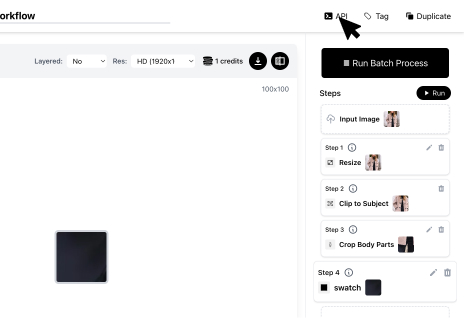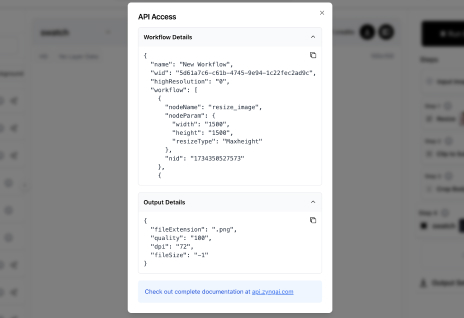Zyng AI API Documentation
Integrate Zyng AI's powerful image processing capabilities into your applications using our straightforward REST API.
Getting Started
Authentication
All API requests must be authenticated
using a Bearer Token. Include your API
key in the
Authorization
header for every request.
Authorization: Bearer {your_api_key}You can find your API key in your Zyng AI account dashboard: https://app.zyngai.com/account
Rate Limits & Request Queueing
Our API implements intelligent request queueing to ensure reliable processing even during high-volume periods. Unlike traditional rate limiting, requests exceeding your tier's limit are automatically queued rather than rejected.
Tier 1
Generally Available
requests per minute
Shared processing queue
Tier 2
Available on Request
requests per minute
Dedicated server & priority queue
Tier 3
Available on Request
requests per minute
Dedicated server & highest priority queue
Smart Request Queueing
When you exceed your tier's rate limit:
- Requests are automatically queued instead of returning errors
- All requests receive a successful response with a valid RID
- Processing order is maintained based on queue priority
- Higher tier customers enjoy faster queue processing
How to Upgrade Your Tier
To request an upgrade to Tier 2 or Tier 3, please email [email protected]. Include your current usage patterns and expected volume to help us better understand your needs. Higher tiers include:
- Dedicated processing servers
- Priority queue processing
- Webhook support
- Enhanced support response times
Base URL
All API endpoints are relative to the following base URL:
https://api.zyngai.comStandard API Flow
The typical interaction with the API follows these steps:
-
Register Request:
Send a
POSTrequest to initialize a processing job and receive a unique Request ID (rid). This step defines the workflow and output settings. -
Process Image(s):
Send one or more
POSTrequests, using theridobtained in step 1, providing the image URL (imglink) and a unique name for each image (image_name). -
Get Results:
Obtain processing results
through one of two methods:
-
Polling Method (All
Tiers):
Periodically send
GETrequests using theridto check processing status and retrieve results. - Webhook Method (Tier 2 & 3): Receive an automatic POST notification to your specified endpoint when processing completes. No polling required.
-
Polling Method (All
Tiers):
Periodically send
Webhook Availability
Webhooks are available for Tier 2 and Tier 3 customers, providing instant notifications when results are ready. See our rate limits section for tier details.
Workflow & Output Parameters
The
workflowDetails
and
outputDetails
objects are crucial for defining how
your images are processed and where they
are delivered. These parameters are
dynamic and depend on the specific
workflow you configure in the Zyng AI
web application.
You can find the exact JSON structure for these parameters within your workflow settings in the Zyng AI app, under "API". Here's where to look:

1. Navigate to your Workflow.

2. Find the API details section.

3. Copy the
workflowDetails
&
outputDetails
JSON.
API Endpoints
1. Register Request
Initializes a new processing job session
and returns a unique Request ID (rid) required for subsequent image
processing calls within that session.
/process_image
Headers:
Content-Type: application/json
Authorization: Bearer {your_api_key}Request Body:
{
"task": "register_request",
"workflowDetails": { /* Workflow configuration object from Zyng AI UI */ },
"outputDetails": { /* Output configuration object from Zyng AI UI */ }
}
-
task: Must be set to
"register_request".
-
workflowDetails: The JSON object defining the
processing steps, copied from your
Zyng AI workflow settings.
-
outputDetails: The JSON object defining output
formats and destinations, copied
from your Zyng AI workflow settings.
Success Response (200 OK):
{
"rid": "a_unique_generated_request_id"
}
-
rid: The unique identifier for this
processing session. Store this ID to
use in the next steps.
2. Process Image
Submits a single image for processing
under an existing Request ID (rid). You can call this endpoint multiple
times with the same
rid
for batch processing.
/process_image
Headers:
Content-Type: application/json
Authorization: Bearer {your_api_key}Request Body:
{
"rid": "a_unique_generated_request_id",
"task": "process_image",
"imglink": "https://your-image-host.com/path/to/image.jpg",
"image_name": "product_photo_variant_1",
"workflowDetails": { /* Same object as in register_request */ },
"outputDetails": { /* Same object as in register_request */ }
}
-
rid: The ID received from the
"Register Request" step.
-
task: Must be set to
"process_image".
-
imglink: A publicly accessible URL to the
source image.
-
image_name: A unique name for this specific
image within the request. Used for
identifying results.
-
workflowDetails: Must be the *exact same* object
provided during registration.
-
outputDetails: Must be the *exact same* object
provided during registration.
Success Response (200 OK):
"Processing Images"A simple string confirmation indicates the image has been queued for processing.
3. Poll Results
Retrieves the status and results for a
processing request identified by its
rid.
Poll this endpoint periodically until
all expected images are processed.
/poll_results?rid={rid}
URL Parameters:
-
rid
(required): The Request ID obtained
from the "Register Request" step.
Headers:
Authorization: Bearer {your_api_key}Success Response (200 OK):
[
{
"iid": "https://images.zyngai.com/processed/path/product_photo_variant_1.png",
"layers": false,
"name": "product_photo_variant_1.png",
"rid": "a_unique_generated_request_id"
},
{
"iid": "https://images.zyngai.com/processed/path/product_photo_variant_2.jpg",
"layers": false,
"name": "product_photo_variant_2.jpg",
"rid": "a_unique_generated_request_id"
}
// ... more image results if available
]
Returns a JSON array. Each object in
the array represents a successfully
processed image from the request.
-
iid: The URL to the final processed
image.
-
name: The filename, often derived from
the
image_name
provided during processing.
-
rid: The request ID this result
belongs to.
-
layers: Indicates if layer information is
available (typically false unless
specifically configured).
Note:
The endpoint returns an empty array
[]
if processing is still ongoing or if
no images have completed yet for the
given
rid. Continue polling until the array
contains the expected number of
results. Implement appropriate
delays and retry logic in your
polling mechanism.
Webhook Alternative
For Tier 2 and Tier 3 customers, we offer webhook notifications when processing is complete, eliminating the need for polling. With webhooks, we'll send a POST request to your specified endpoint with the same response format as the polling endpoint when results are ready.